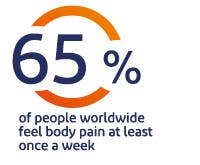Symptoms of wrist pain
Wrist and hand pain may be experienced in many different ways and can really affect your quality of life.
Wrist pain may stop you from carrying out basic activities such as lifting things, writing, typing, or putting weight on your hand or wrist.
01
Weakness, numbness, tingling, tenderness, inflammation and problems moving wrists and hands freely can also occur in various wrist problems.
02
If your wrist is injured it may appear bruised and swollen and you may have difficulties moving it.
03
How wrist pain can affect you
Wrist pain can make it difficult to perform activities that require easy movement of your hands and wrist, such as typing or playing the piano.
Did you know?
The bones in the wrist include the ends of the radius and ulna (the long bones of the forearm) and eight carpal bones (the bones of the wrist).
51% of people with pain globally experience pain in their hands.
Why do we experience wrist pain?
There are many reasons why you could be experiencing wrist pain, which can make it difficult to diagnose the exact cause of your wrist pain.

Common causes of wrist pain
Wrist pain is often caused by sprains or sprains from injuries, while injury or overuse can also cause tendonitis (inflammation of the tendons) or bursitis (where fluid builds up in the sac of fluid that cushions the wrist joints, called the bursa).

Some factors might increase the risk of wrist pain
There are some activities that are more likely to cause wrist pain, including sports that involve lots of wrist movement like bowls or tennis, and jobs that require repetitive work such as typing and cutting hair. If you’re overweight or have diabetes you are also more likely to experience wrist pain.
Expert treatment
Usually wrist pain does not require medical care and minor sprains and strains respond to ice, rest and over-the-counter pain medications such as non-steroidal anti-inflammatory drugs (NSAIDs). These help reduce the inflammation and alleviate the pain. There are many causes of wrist pain. You can often ease the pain yourself. But talk to your GP if the pain does not improve.

How to alleviate wrist pain
Explore our range
Find out how our products can help
Discover the Voltarol product range to find the right product to treat your pain.

Learn more
What is pain?
Understand why our bodies experience the sensation of pain and the many causes of body pain.
read moreLearn about your body and how it changes as you age
Find out how your body works, changes you may experience as you get older, and how to deal with age-related body pain.
read moreExplaining the different types of pain
Learn more about the different types of pain you might experience and discover what lies behind the pain we feel.
read more
















